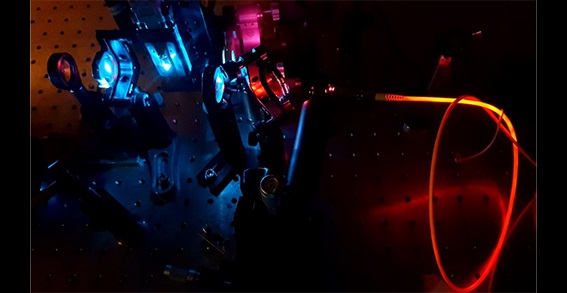06 May 2020
Over the past three decades, the development of tunable laser sources capable of emitting femtosecond pulses (10-15 sec) from the ultraviolet to mid-infrared has proven to be of major importance for many applications, ranging from spectroscopy to biomedicine. Optical parametric oscillators (OPOs) are host to a rich variety of nonlinear optical effects, which makes them especially versatile sources of high-power, high-repetition-rate femtosecond pulses across vast spectral regions that are impossible to access with conventional lasers.
For many everyday applications, simplicity and small form-factor of the laser light source are deciding factors for the success or failure of a technology. Despite outstanding performance characteristics, stable long-term operation of femtosecond OPOs requires careful control of dispersion and cavity length, resulting in costly and complex system designs with large device footprint.
In a study recently published in Optica, ICFO researchers, Callum F. O’Donnell and T. Paoletta, led by Dr. S. Chaitanya Kumar and ICREA Prof. at ICFO, M. Ebrahim-Zadeh, report on the development of the next-generation of OPOs embedded in a novel fiber-feedback architecture, and producing tunable soliton pulses (wave-packets of light that maintain their shape in space and time) with sub-100 fs duration in the near-infrared.
In their experiment, the team of researchers realised a viable and stable femtosecond OPO source in a highly compact, practical, and simplified design using a standard telecom fiber within the optical cavity. With this fibre-feedback approach, they were able to generate solitons within an OPO, for the first time, which could be rapidly tuned across a wide wavelength range using the variation of QPM grating period and cavity length. In addition, by using this technique, they could generate such stable soliton pulses even in the presence of continually varying dispersion and nonlinearity effects.
The successful demonstration of their fiber-feedback concept has proven the feasibility of a compact femtosecond OPO footprint, and also enabled the study of soliton dynamics over a broad spectral range.

A new generation of OPOs
ICFO researchers develop a new generation of optical parametric oscillators (OPOs) that can provide tunable soliton pulses with sub-100 fs duration in the near-infrared.

Highly compact fiber-feedback femtosecond optical parametric oscillator generating tunable solitons across the near-infrared. © ICFO/ S. Chaitanya Kumar











